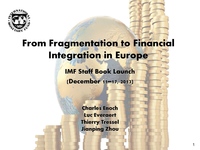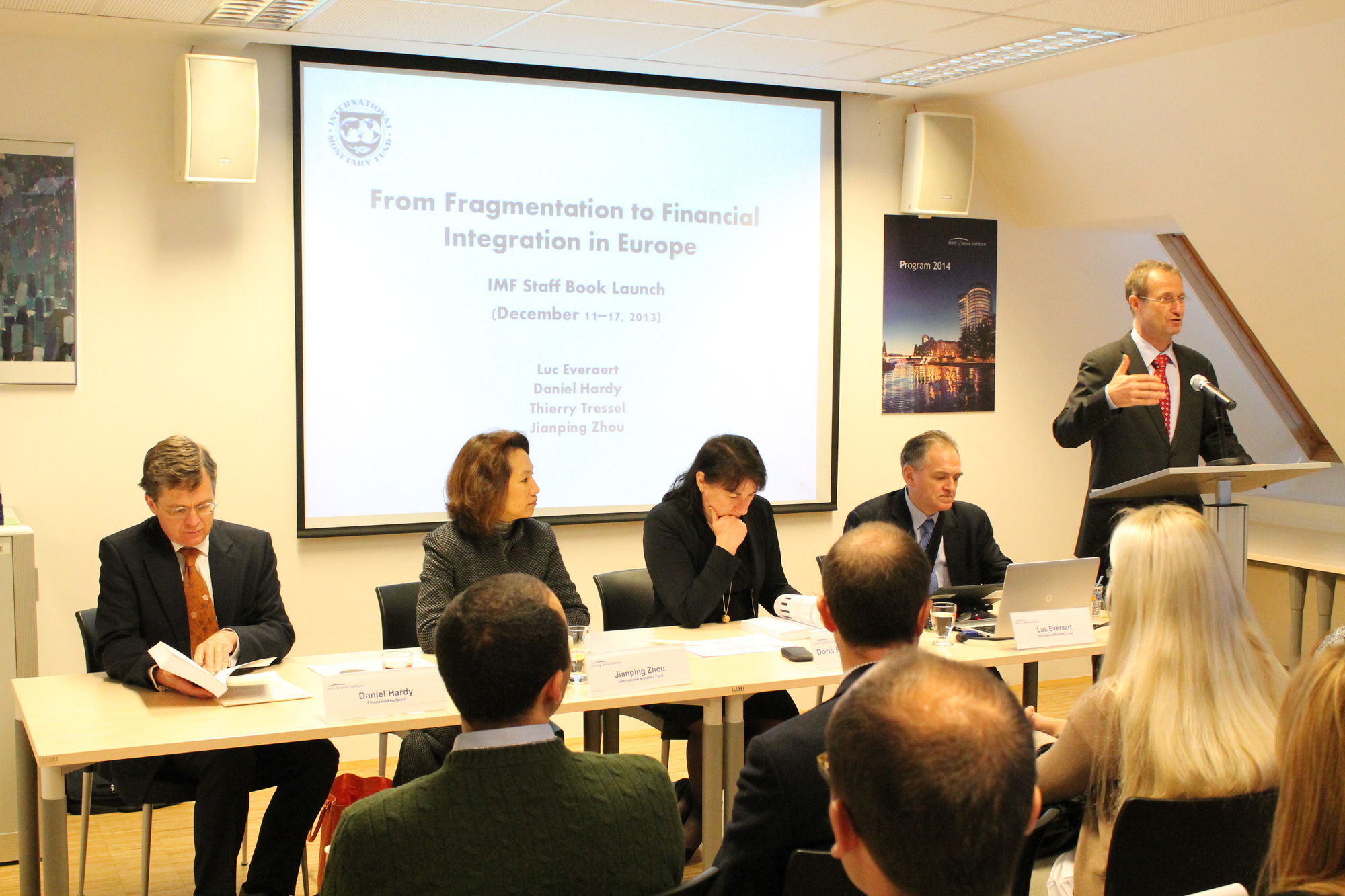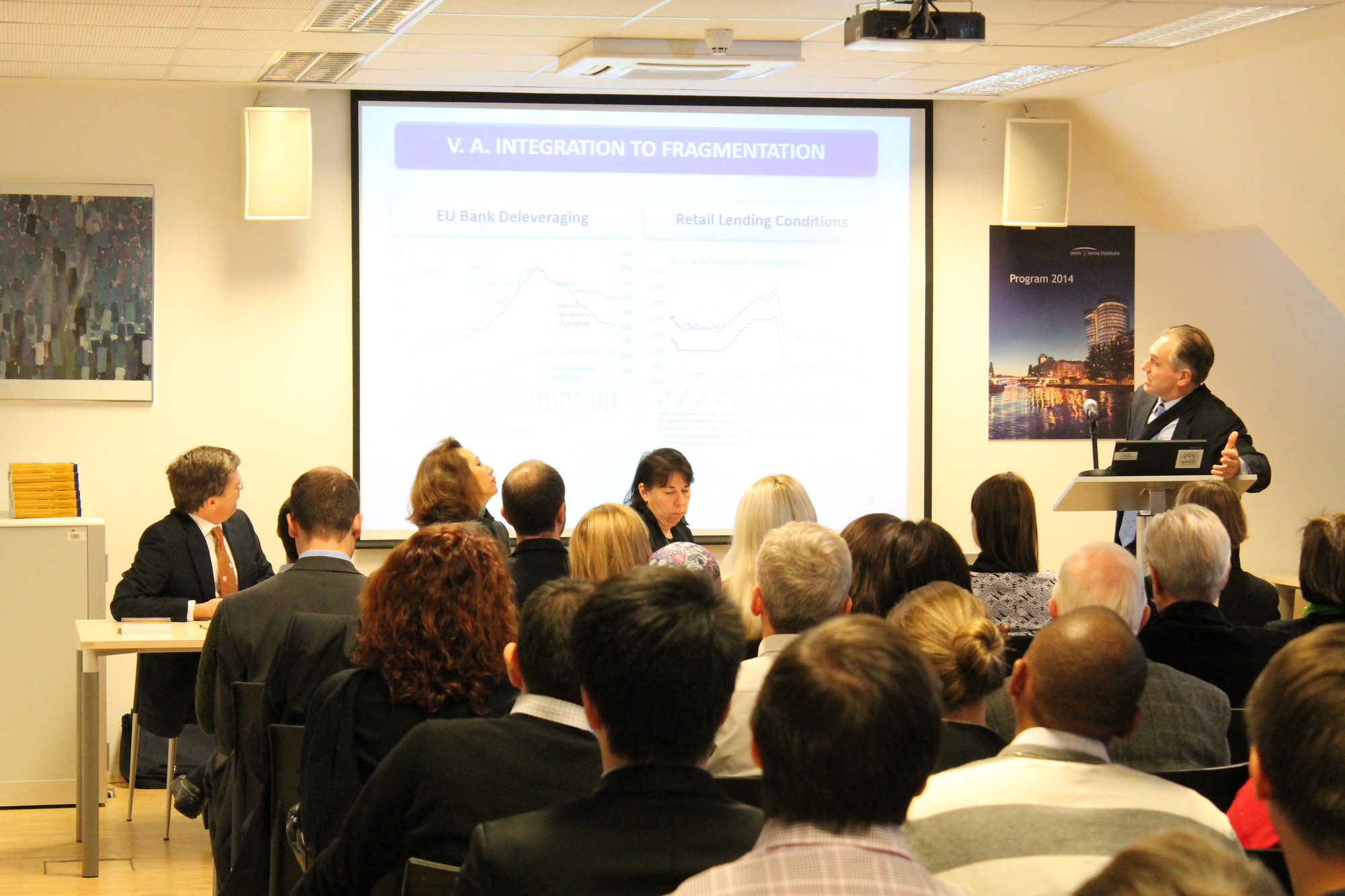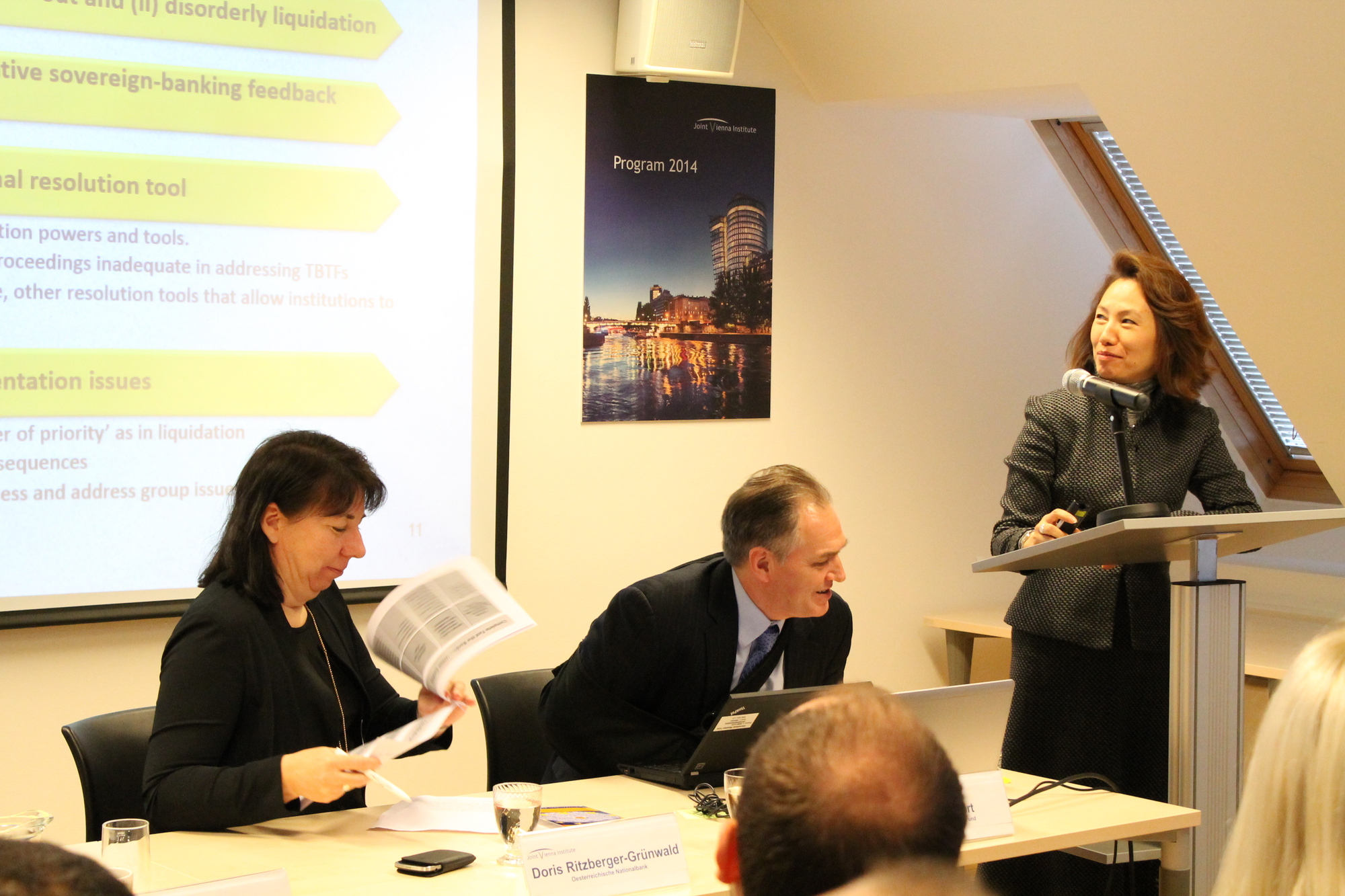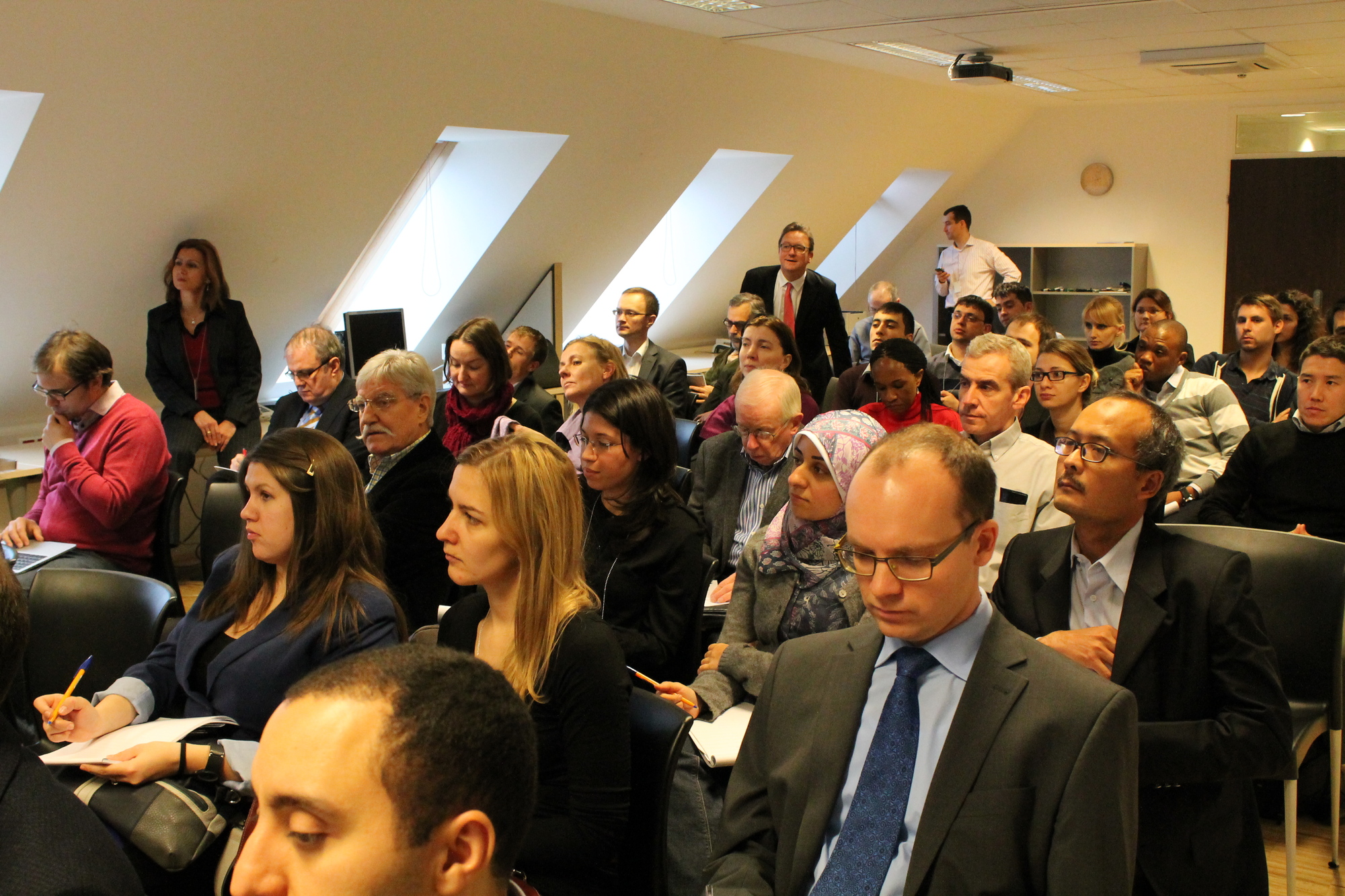Tuesday, December 17
Presenters
Charles Enoch
Luc Everaert
Thierry Tressel
Jianping Zhou
Summary
On 17 December 2013, the JVI hosted a book launch event for the new IMF book From Fragmentation to Financial Integration in Europe. The book is an outgrowth of the first supra-national Financial Sector Assessment Program (FSAP) undertaken by the IMF for the European Union as a whole in late 2012, assessing region-wide financial stability in Europe. It documents the tension between national fragmentation and EU-wide solutions, not least in the on-going debate on a full-fledged banking union.
The event was introduced by Mr. Norbert Funke, Director of the JVI, and chaired by Ms. Doris Ritzberger-Grünwald, Director of the Economic Analysis and Research Department of the OeNB. In her introductory remarks, Ms. Ritzberger-Grünwald praised the book for showing clearly how difficult, and yet how important it is to build an integrated financial system and establish effective oversight in Europe. Fragmentation is an issue not only in financial services, but also in monetary policy for the euro area, as evidenced by differences in credit conditions across countries. While in monetary policy the ECB is trying to overcome the fragmentation via its unconventional monetary operations, implementation of the banking union in Europe should help integration because the single European supervisor would treat the EU financial market as one market and harmonize supervisory practices.
Mr. Luc Everaert, Assistant Director in the IMF’s Monetary and Capital Markets Department, and Ms. Jianping Zhou, Senior Economist in the same department – who edited the book together with Charles Enoch and Thierry Tressel of the IMF – jointly presented the content of the book and its key findings. The first part of the book titled “From Integration to Crisis Management” describes the EU’s progress in integrating its financial system before the global financial crisis, including its institutional framework, and describes how Europe coped with the global financial crisis. The second part of the book on “Underpinning Financial Stability” discusses necessary features of a proper banking union in the EU, including its legal background, the Single Supervisory Mechanism (SSM), the Single Resolution Mechanism (SRM), and common deposit insurance. It also tackles specific issues regarding, for example, governance and transparency of EU regulatory and supervisory institutions, stress testing, bailing in private creditors in case of bank failures, and the regulation of nonbank financial institutions and infrastructure. The final part of the book “Beyond the Crisis” reviews some structural issues related to the new European financial architecture.
Key findings of the book can be summarized as follows. First, the pre-crisis EU institutional features and the absence of an EU-wide crisis management amplified the crisis. Lack of authority at the level of the EU institutions contributed to negative sovereign-banking loops and financial fragmentation. Thus, a regional EU-wide approach to financial stability is needed to safeguard a single market for financial services, and is all the more important in the single currency area.
Second, important steps have been taken. Banks have boosted their capital adequacy ratios, although partly through deleveraging. Unconventional monetary operations of the ECB have enhanced liquidity, and new tools for addressing financial stability have been introduced, including coordinated stress tests. Supra-national sovereign support was established via the European Stability Mechanism (ESM). The newly established European Supervisory Authorities (ESAs) as well as the new EU macroprudential body European Systemic Risk Board (ESRB) are making their marks. Progress has been made with bank resolution and restructuring, and market confidence was enhanced with the agreement that was reached in December 2012 to establish the SSM for the euro area, but open also to non-euro area members. However, gaps remain. The EU institutions (ESAs, ESRB) are still evolving, and confidence in European banks is not fully restored, as market concerns about the quality of bank assets remain. Vulnerabilities are exacerbated by the still-fragmented financial system, regulatory and policy uncertainty, and the major gaps in the policy framework that still need to be filled.
The book presents three main recommendations. First, the repair of the banks’ balance sheets should be completed. Full repair would need to be underpinned by a proper supervisory assessment, asset quality review, and firm stress tests within the new SSM, as well as by implementing fully regulatory reforms and enhancing disclosure. Second, the banking union should be swiftly completed. The ECB should be assigned adequate authority and resources, and a single resolution mechanism with common backstops should be established. Third, better coordination should be established amongst the various agencies, and an integrated crisis management system should be set up. The role of ESAs and ESRB should be refocused to support and complement the banking union’s SSM and SRM.
Mr. Daniel Hardy from the Austrian Financial Market Authority (currently on leave from the IMF), served as a discussant. He mentioned that in Austria, financial integration is an important issue given Austrian banks’ large cross-border exposures and Austria’s role as a host to institutions from other European countries. He emphasized that the book does not cover only banks, but also other financial intermediaries such as insurance companies. He stressed the benefits of a functioning banking union and single supervision in Europe, but noted that many challenges and risks remain on the way to their full implementation, and that the book’s recommendations are complementary. In particular, integrated regulation and supervision requires, and is required by, effective crisis management with burden sharing.
A rich discussion followed, touching upon: the possible costs and benefits of financial integration in Europe; the differences between the type of financial integration in Central and Eastern Europe (based on foreign ownership of banks) and that in Western Europe (based mainly on debt flows); the role of government-sponsored bad banks as crisis management tools; and the proper regulatory treatment of sovereign risk. Other questions that were discussed included: whether the EU also needs a fiscal union or whether the ESM was sufficient to provide a credible backstop mechanism; whether deposit insurance needed to be unified in the EU; and whether the SSM would lead to improved conduct of supervision, given that the single supervisor may be better protected from national regulatory capture.
Adam Gersl, Senior Economist, JVI


